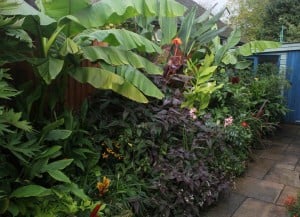Winter pruning of apple and pear trees is important so that they remain attractive, easy to manage, healthy and crop prolifically. You can prune anytime between leaf fall and bud burst, providing the weather is not cold and frosty; the aim is to create an open goblet shape.
First, remove any shoots or branches that are dead, diseased, dying, crossing, rubbing or weak stems using a sharp pair of secateurs, loppers or pruning saw. Always wear gloves when you’re using a sharp pruning saw, it only takes one slip of the blade – I’ve had five stitches in my hand to prove it! If you are opening up the centre of a tree and removing larger branches, spread the job over two or three years as hard pruning produces masses of unwanted vigorous growth or ‘water shoots’. Finally, reduce the height and spread if needed by cutting large branches back by 1/3 to a strong outward facing branch.
 Then, if your tree is spur fruiting, cut back this year’s growth by about 1/3rd to an outward facing bud and the side shoots to five or six buds (3’n’6). On tip bearers, prune the main shoots and laterals back to one bud. Do this early in the month and the pruning’s can be the basis of your Guy Fawkes Night bonfire!
Then, if your tree is spur fruiting, cut back this year’s growth by about 1/3rd to an outward facing bud and the side shoots to five or six buds (3’n’6). On tip bearers, prune the main shoots and laterals back to one bud. Do this early in the month and the pruning’s can be the basis of your Guy Fawkes Night bonfire!
It is amazing that the weather is still so warm. I’ve been picking late tomatoes – they are currently ripening on the greenhouse staging. Any don’t ripen within a few days and are undamaged, will be put in an old draw indoors, checked regularly to remove those showing signs of deterioration and brought out onto the windowsill or put in a paper bag with a ripe banana using the ethylene it produces, to ripen.
It is also time to insulate your greenhouse with bubble wrap to reduce heating costs over winter. Before doing so it is worth working out the kinds of plants you are overwintering and dividing the greenhouse into sections for plants needing different temperatures and conditions. Some, like my species pelargonium’s only need to be kept frost free, others, like my tropical plants will stay in the propagator where it is warm and humid. After the first frosts, Canna’s from my tropical border (see picture) will be lifted, the soil removed, stems cut back to 6”, then stored in trays of multi-purpose compost in a frost free place. It is important to check them regularly over winter as they may need a little water to prevent them from desiccating. Dahlia’s will be lifted, allowed to dry so the soil can be brushed off, the stems cut back to about 6”, they will be turned upside down to drain and dry, then the tubers just covered with multi-purpose compost. When storing dahlias and canna’s one thing is vitally important. Never let the labels become separated from the plants or you will have to wait until next year to discover who’s who!
Happy gardening! Take care, Matt


